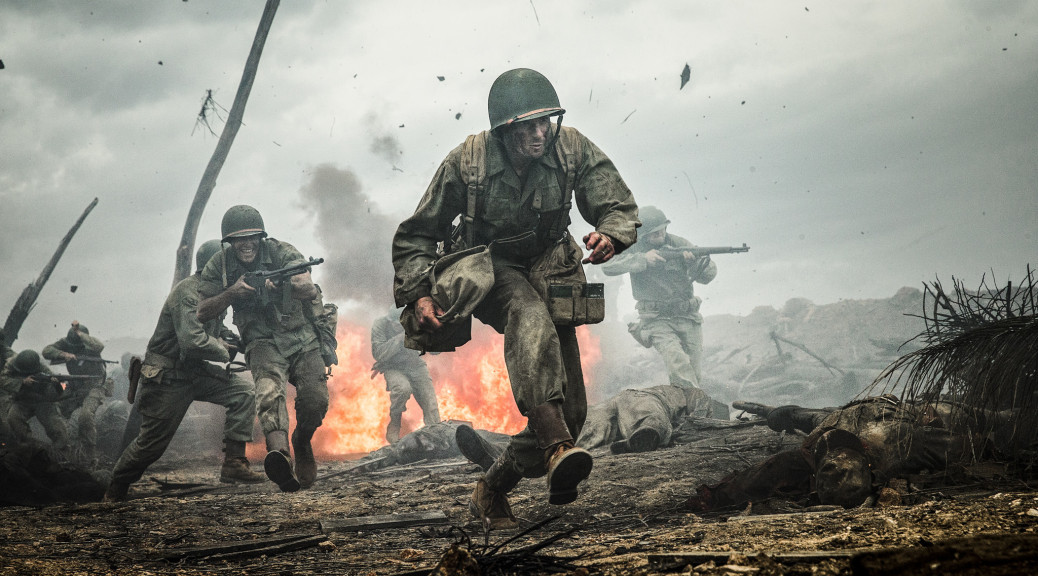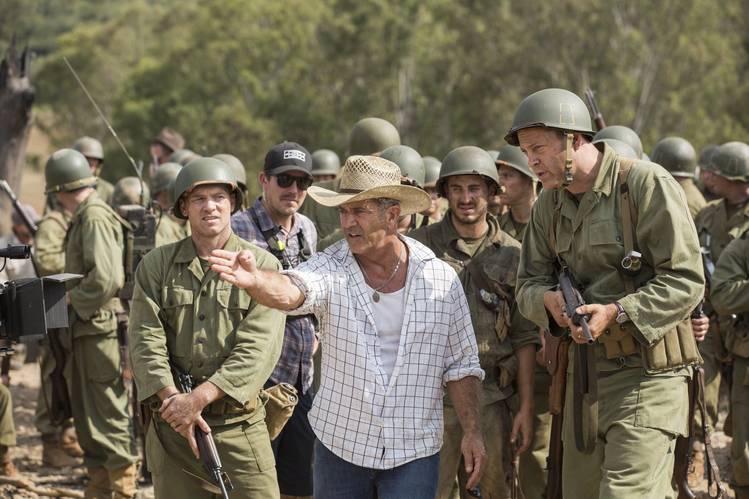
It’s impossible to talk about Hacksaw Ridge without first getting the subject of Mel Gibson out of the way, since this film marks his return to the director’s chair after over a decade of exile following a series of, um, incidents. My honest opinion of Gibson is that he is mentally ill, as there were no “incidents” (to be clear “incidents” means “horrific racist blow-ups”) in the over 20 years he’d spent in Hollywood, at least that I’m aware of, prior to roughly about the time he made The Passion of the Christ. He’s certainly had his career marred for life for his behavior and any hint of it rising again will see a now-socially networked Hollywood descend on him and pick him to pieces. That’s a long-winded way of saying Hacksaw Ridge isn’t just Mel Gibson’s return; it’s his last chance with an industry and public filled with people he’s slandered. That being said, Hacksaw Ridge premiered at the Venice Film Festival to a 10-minute standing ovation at the film’s ending. Whether that’s a byproduct of the industry’s bizarre tendency to selectively forgive despicable behavior (looking at you, Roman Polanski) or because Hacksaw Ridge‘s last hour deserves that reaction is tough to discern. It is Mel Gibson’s best directorial effort since he won two Oscars for Braveheart, a unique story of a unique hero, and one of the most powerful and moving films of 2016.

Hacksaw is a very different film than previous Gibson works in, if nothing else, its treatment of violence. Whereas his directing efforts have almost uniformly been extremely violent films, that violence existed as a byproduct of the times in which those films took place ( though you could certainly make the argument that an extra helping was added that wasn’t necessary). Hacksaw Ridge is a film that treats violence with a disgust that was absent in prior Gibson efforts (that’s not to say there isn’t a whoooooole lot, but we’ll get to that). The first half of the film introduces you to Desmond Doss (Andrew Garfield in a wonderful performance that promises his career will survive Spider-Man). Doss grows up with violence a constant presence in his home thanks to his shell-shocked WWI veteran father’s abusive behavior (Hugo Weaving, who I thought was miscast and one of the film’s weak points). When one of those abusive outbursts nearly leads him to kill his father, he takes a vow before God to never touch a gun for the rest of his life; that violence would not swallow him the way it did his father.
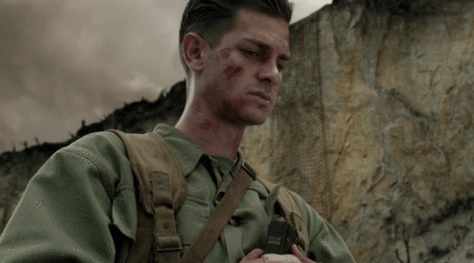
This is, as an aside, almost a Christian film if the Christian film industry made films that included real people and not walking homilies. It’s unapologetic in it’s Biblical views, and given the convictions of the man it chronicles, it needs make no apology. If, in places, those convictions threaten to become preachy or eye-rolling early in the film, that’s obliterated by when they’re put to the test when Doss signs up to serve in World War II as a medic and a conscientious objector. Fiercely patriotic, Doss felt he had no right to sit at home while everyone around him was going to war, but his plan to serve without touching a firearm was met by the US Army with something bordering on hysteric incredulity.
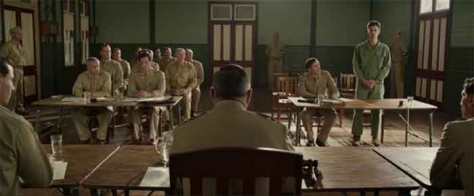
The sequence of Doss in boot camp and his battle with the Army to serve on his terms is extremely well-done. It effectively introduces you to the soldiers with whom Doss would be serving, and presents the Army’s clear opinion that Doss is a lunatic without making them villainous or denigrating Desmond’s beliefs. Vince Vaughn of all people, gets a fantastic series of scenes as Desmond’s drill sergeant, his introduction joining a longstanding military film tradition of outstanding drill sergeant grand entrances to the barracks. Doss prevails in his crusade to serve, despite being wanted by no one and given every chance to bow out. After a court martial hearing over his refusal to bear arms in which Doss prevails, the film then jumps directly from 1942 to 1945 (skipping most of the war) to the battle of Okinawa; one of the final battles in the WW2’s Pacific campaign and Hacksaw Ridge.

Those who have watched the two peerless HBO miniseries on World War II: Band of Brothers and The Pacific know why it’s the European theater of the war that has gotten most of the attention from Hollywood. It’s got the villain, great characters and amazing stories in a fairly linear drive from D-Day to V-E Day. The Pacific campaign was, from its outset, a bloody, disease-ridden, difficult to follow series of naval and island hopping marine and jungle battles whose outcome was give and take for most of the war. Every inch toward the Japanese home islands was soaked in blood, and nowhere more so than Okinawa. Hacksaw Ridge was a vertical bluff where the Japanese were entrenched at the top in a series of bunkers and tunnels. To reach them in the first place, you needed to climb a vertical cargo net up the ridge, and at the top you were immediately met with the full resistance of the Japanese. The only way to get them up was to have naval ships hammer the area with artillery fire and give them a window to get enough men up the ridge to begin a “battle”. The quotes indicate the level of success the Allies had in staying on the Ridge, as wave after wave of death forced them back down the net.
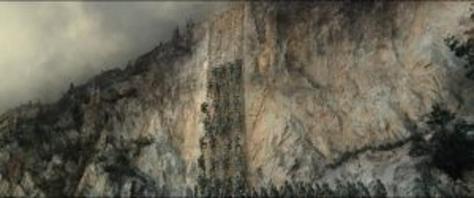
Doss and his squadron were sent up the net and it is here that Gibson presents a 45 minute long battle for Hacksaw Ridge that makes the opening of Saving Private Ryan look like Mister Rogers’ Neighborhood. To be clear, the level of violence presented is accurate, and I have no problem with it whatsoever. I think it’s irresponsible to make a war film that presents the violence inherent to it as anything other than the nightmare which it is. Gibson presents this unflinchingly as the Allied forces struggle to make any progress, their backs literally against a cliff. Doss went into this charnel house completely unarmed. Treating his fellow soldiers to the best of his ability, Doss was left behind when the Allies were forced to retreat once more as night fell. Doss was not alone, as Allied wounded were littered across the battlefield.
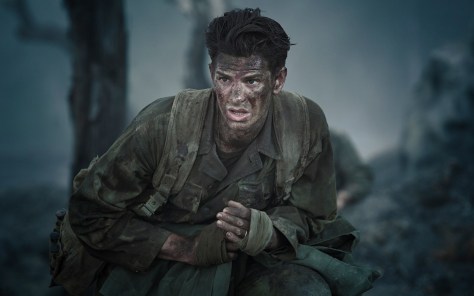
During the course of the night, Doss went from man to man, triaging them, then literally dragging them to the edge of the ridge where he would lower them down in a jury-rigged rope sling. This is the film’s triumph. It’s an astounding feat of courage and faith, and it’s impossible not to be moved as Desmond prays, “Lord, just let me get one more.,” and heads back out into the uncertain night. Over that night, Desmond Doss lowered 75 men including wounded Japanese soldiers he came across. He was injured four times during the battle, and was the first conscientious objector to ever receive the Medal of Honor. It’s an astounding feat of courage and if the first half of the film can drag in spots, Gibson’s direction of the battle is peerless and Garfield’s depiction of Desmond’s heroics should earn them both Oscar nominations.
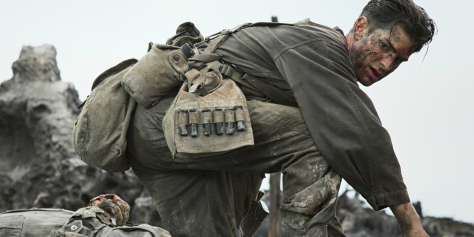
Gibson wisely ends the film by transitioning to historical footage of Doss and those with whom he served talking about his bravery and conviction. He lets the truth literally speak for itself and there could be no other way to end this most unique of war stories. Hacksaw Ridge is imperfect as a film, but it is an amazing story of an amazing man told in a towering, powerful tribute. Doss was a true hero and deserves this enduring tribute to his faith and courage that will keep his story alive for generations to come. (Read below for a little on the real Desmond Doss)
9.25/10
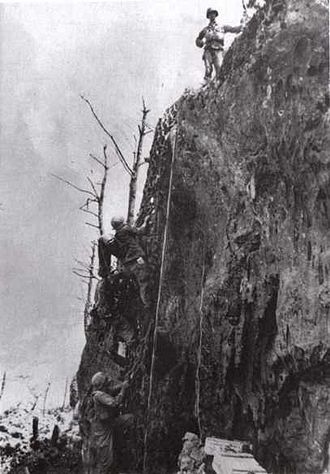
Not only was Doss wounded four times on Okinawa as you see the real Hacksaw Ridge above, he later contracted tuberculosis on Leyte so severely that he was treated over five-and-a-half years, losing a lung and five ribs before being discharged from the Army in 1951 with a 90% disability. As for if he was really the hero the film makes him out to be, what follows below is the citation from Desmond’s Medal of Honor Ceremony:
The President of the United States of America, in the name of Congress, takes pleasure in presenting the Medal of Honor to Private First Class Desmond Thomas Doss, United States Army, for conspicuous gallantry and intrepidity in action above and beyond the call of duty from April 29 – 21 May 1945, while serving with the Medical Detachment, 307th Infantry Regiment, 77th Infantry Division, in action at Urasoe Mura, Okinawa, Ryukyu Islands. Private First Class Doss was a company aid man when the 1st Battalion assaulted a jagged escarpment 400 feet high. As our troops gained the summit, a heavy concentration of artillery, mortar and machine gun fire crashed into them, inflicting approximately 75 casualties and driving the others back. Pfc. Doss refused to seek cover and remained in the fire-swept area with the many stricken, carrying all 75 casualties one-by-one to the edge of the escarpment and there lowering them on a rope-supported litter down the face of a cliff to friendly hands. On May 2, he exposed himself to heavy rifle and mortar fire in rescuing a wounded man 200 yards forward of the lines on the same escarpment; and 2 days later he treated 4 men who had been cut down while assaulting a strongly defended cave, advancing through a shower of grenades to within eight yards of enemy forces in a cave’s mouth, where he dressed his comrades’ wounds before making 4 separate trips under fire to evacuate them to safety. On May 5, he unhesitatingly braved enemy shelling and small arms fire to assist an artillery officer. He applied bandages, moved his patient to a spot that offered protection from small arms fire and, while artillery and mortar shells fell close by, painstakingly administered plasma. Later that day, when an American was severely wounded by fire from a cave, Pfc. Doss crawled to him where he had fallen 25 feet from the enemy position, rendered aid, and carried him 100 yards to safety while continually exposed to enemy fire. On May 21, in a night attack on high ground near Shuri, he remained in exposed territory while the rest of his company took cover, fearlessly risking the chance that he would be mistaken for an infiltrating Japanese and giving aid to the injured until he was himself seriously wounded in the legs by the explosion of a grenade. Rather than call another aid man from cover, he cared for his own injuries and waited 5 hours before litter bearers reached him and started carrying him to cover. The trio was caught in an enemy tank attack and Pfc. Doss, seeing a more critically wounded man nearby, crawled off the litter; and directed the bearers to give their first attention to the other man. Awaiting the litter bearers’ return, he was again struck, by a sniper bullet while being carried off the field by a comrade, this time suffering a compound fracture of one arm. With magnificent fortitude he bound a rifle stock to his shattered arm as a splint and then crawled 300 yards over rough terrain to the aid station. Through his outstanding bravery and unflinching determination in the face of desperately dangerous conditions, Pfc. Doss saved the lives of many soldiers. His name became a symbol throughout the 77th Infantry Division for outstanding gallantry far above and beyond the call of duty.

